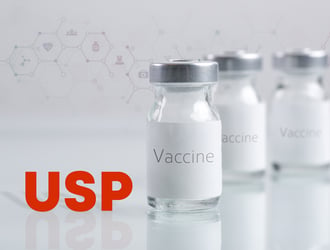Subvisible particles (those 2-100 μm in diameter) in protein, cell, and gene therapies and other parenteral drug products pose risks to the safety and efficacy of these therapies. To mitigate these potential issues, the United States Pharmacopeia (USP) requires researchers to monitor the subvisible particle content of biotherapeutics and other parenteral drug products. These requirements can be found in USP <788>, <787>, and <789>.
In addition to these requirements, USP also poses recommendations for subvisible particle measurements in USP <1787>1 and <1788>2. Note that these USP chapter numbers are greater than 1000, indicating that these are informational chapters and do not contain mandatory tests. While the tests described are optional, following these suggestions can help scientists more effectively monitor and control the subvisible particle content of their therapies. Here we provide an overview of USP <1787> and <1788> chapters and the particle monitoring strategies they propose. It will also discuss how FlowCam, a flow imaging microscopy (FIM) instrument, can help researchers meet these recommendations and otherwise improve the quality of their medicines.
Download the White Paper: USP Reference Standards for Subvisible Particulate Matter
USP <1787>: Measurement of Subvisible Particulate Matter in Therapeutic Protein Injections
This chapter focuses on strategies for characterizing subvisible particles in protein therapies. The drug substance of these treatments will often form protein aggregate particles. Aggregates are an inherent particle type or one that is expected to appear due to the nature of the drug substance and may be an acceptable attribute of the final drug product. Since they are naturally generated by the drug substance, protein particles are more challenging to control than intrinsic and extrinsic particle types—those from sources within the drug product and manufacturing process or outside the normal manufacturing process, respectively. Aggregates are also difficult to analyze using traditional particle monitoring strategies due to their low refractive index and flexible structures.
USP <1787> provides recommendations to help researchers characterize protein aggregate particles and distinguish them from other important intrinsic and extrinsic particle types like silicone oil droplets. It strongly recommends using multiple complementary and orthogonal analytical techniques in addition to the compendial light obscuration (LO) and membrane microscopy methods to analyze these particles. Several analytical techniques that can be considered for this purpose are discussed in this chapter, including flow imaging microscopy (FIM), electrical sensing zone, and electron microscopy. It also recommends monitoring particles between 1-10 μm in size since most samples will exhibit high protein aggregate concentrations in this size range.
While USP <1787> primarily applies to protein therapies, as indicated in USP <1788>, many of these recommendations can also help characterize particles in other parenteral drug products. For example, analytical techniques like FIM can be used to monitor viral and nonviral vector aggregates in gene therapies as well as cell clusters and debris in cell therapies.
USP <1788>: Methods for the Determination of Subvisible Particulate Matter
This chapter is meant to provide more specific instructions and suggestions for how the methods in USP <788>, <787>, and <789> are to be performed. It includes general recommendations on defining an effective subvisible particle monitoring strategy, including sampling plans, testing environment, and sample handling. USP <1788.1> and <1788.2> provide more specific guidance on the light obscuration and membrane microscopy methods in USP <788>, respectively. This includes method-specific testing considerations and relevant instrument standardization and system suitability tests.
USP <1788> also provides explicit guidelines for performing flow imaging microscopy (FIM, referred to as “flow imaging” or FI in the chapter) measurements similar to those offered for the LO and membrane microscopy methods. FIM was included along with the compendial techniques in this chapter due to its effectiveness in characterizing particle morphology and source. The specific recommendations for FIM measurements can be found in USP <1788.3>.
Flow imaging microscopy is a recommended technique for subvisible particle analysis
As highlighted in both USP <1787> and <1788>, FIM is a recommended orthogonal technique to the two compendial methods, especially during development. Both chapters highlight the value of the particle morphology information FIM provides in identifying the types of particles present in a sample. Unlike membrane microscopy, FIM captures this information with an in-solution measurement, allowing “soft” particles like protein aggregates and silicone oil droplets to be analyzed. FIM can also provide an orthogonal measure of particle concentration and size, offering higher sensitivity to protein aggregates and other transparent particle types than light obscuration offers.
As it is not a compendial technique, FIM is often used as an orthogonal technique to light obscuration to capture particle morphology data that LO does not provide while still meeting pharmacopeia requirements. FlowCam LO can be used to perform both FIM and LO measurements with a single instrument and no additional sample volume. Doing so makes FIM measurements easy to integrate into lot release processes, allowing researchers to preemptively identify unwanted particle sources and process upsets before they are severe enough to cause batch rejections or changes in product efficacy.
As with the compendial methods, it is often helpful to perform FIM measurements in a manner that aligns with USP recommendations. All FlowCam 8000 series instruments meet the specifications for FIM instruments in USP <1788.3>. Additionally, the LO module in FlowCam LO is compliant with the recommendations in USP <1788.1> for LO instruments. More information on how FlowCam complies with recommendations for flow imaging and light obscuration methods can be found in the technical notes “Meeting USP Standards for Subvisible Particulate Matter with FlowCam: Flow Imaging Method” and “Meeting USP Standards for Subvisible Particulate Matter with FlowCam LO: Light Obscuration Method”, respectively.
FlowCam and Silicone Oil Droplet Monitoring
Many injectable protein therapies and other biotherapeutics can contain silicone oil droplets. These droplets often stem from the lubricant used in many syringes but can also come from other siliconized equipment. USP <1787> and <1788> both recommend monitoring the concentration of silicone oil droplets in biotherapeutics as their impact on patient safety likely differs from that of protein aggregates and other particle types.
Historically, researchers analyzed the silicone oil content in a sample by comparing the particle concentrations measured by light obscuration and membrane microscopy since the latter does not detect silicone oil droplets. With FlowCam and FIM, researchers can use image data to determine the silicone oil content in a sample directly, and without having to rely on two different methods, each of which has its own bias. Flow imaging microscopy analysis is simplified further using VisualAI, an artificial intelligence-driven image analysis tool that can recognize FlowCam images of protein aggregate particles and silicone oil droplets from any drug product, allowing users to easily and accurately monitor concentrations of subvisible particle types in samples.
Following the recommendations in USP <1787> and <1788> researchers can accurately and reliably detect changes in subvisible particle content that can compromise product safety and quality. FlowCam instruments assist researchers in following USP <1787> and <1788> recommendations, providing flow imaging microscopy measurements that can track and control the amount of protein aggregates, silicone oil droplets, and other unwanted particle sources in biotherapeutic drug products.
References:
-
United States Pharmacopeia. USP <1787> Measurement of Subvisible Particulate Matter in Therapeutic Protein Injections.
-
United States Pharmacopeia. USP <1788> Methods for the Determination of Subvisible Particulate Matter.










